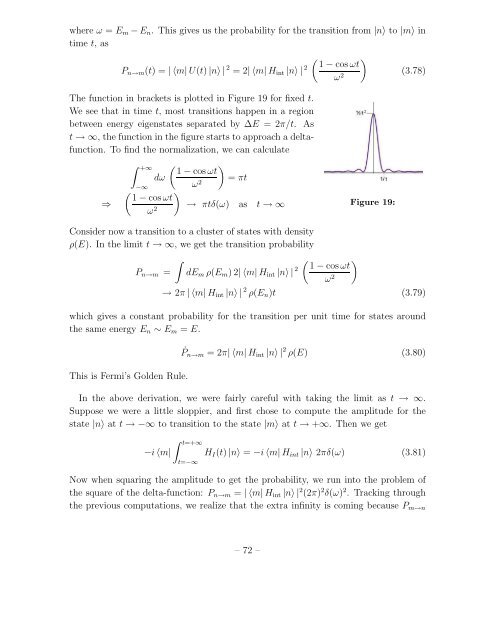Quantum Field Theory
Quantum Field Theory
Quantum Field Theory
You also want an ePaper? Increase the reach of your titles
YUMPU automatically turns print PDFs into web optimized ePapers that Google loves.
where ω = E m −E n . This gives us the probability for the transition from |n〉 to |m〉 intime t, as( ) 1 − cosωtP n→m (t) = | 〈m| U(t) |n〉 | 2 = 2| 〈m| H int |n〉 | 2 (3.78)ω 2The function in brackets is plotted in Figure 19 for fixed t.We see that in time t, most transitions happen in a regionbetween energy eigenstates separated by ∆E = 2π/t. Ast → ∞, the function in the figure starts to approach a deltafunction.To find the normalization, we can calculate⇒∫ +∞( ) 1 − cos ωtdω = πt−∞ ω( )21 − cosωt→ πtδ(ω) asω 2t → ∞Figure 19:Consider now a transition to a cluster of states with densityρ(E). In the limit t → ∞, we get the transition probability∫( ) 1 − cosωtP n→m = dE m ρ(E m ) 2| 〈m|H int |n〉 | 2 ω 2→ 2π | 〈m| H int |n〉 | 2 ρ(E n )t (3.79)which gives a constant probability for the transition per unit time for states aroundthe same energy E n ∼ E m = E.This is Fermi’s Golden Rule.˙ P n→m = 2π| 〈m|H int |n〉 | 2 ρ(E) (3.80)In the above derivation, we were fairly careful with taking the limit as t → ∞.Suppose we were a little sloppier, and first chose to compute the amplitude for thestate |n〉 at t → −∞ to transition to the state |m〉 at t → +∞. Then we get−i 〈m|∫ t=+∞t=−∞H I (t) |n〉 = −i 〈m|H int |n〉 2πδ(ω) (3.81)Now when squaring the amplitude to get the probability, we run into the problem ofthe square of the delta-function: P n→m = | 〈m| H int |n〉 | 2 (2π) 2 δ(ω) 2 . Tracking throughthe previous computations, we realize that the extra infinity is coming because P m→n– 72 –
















